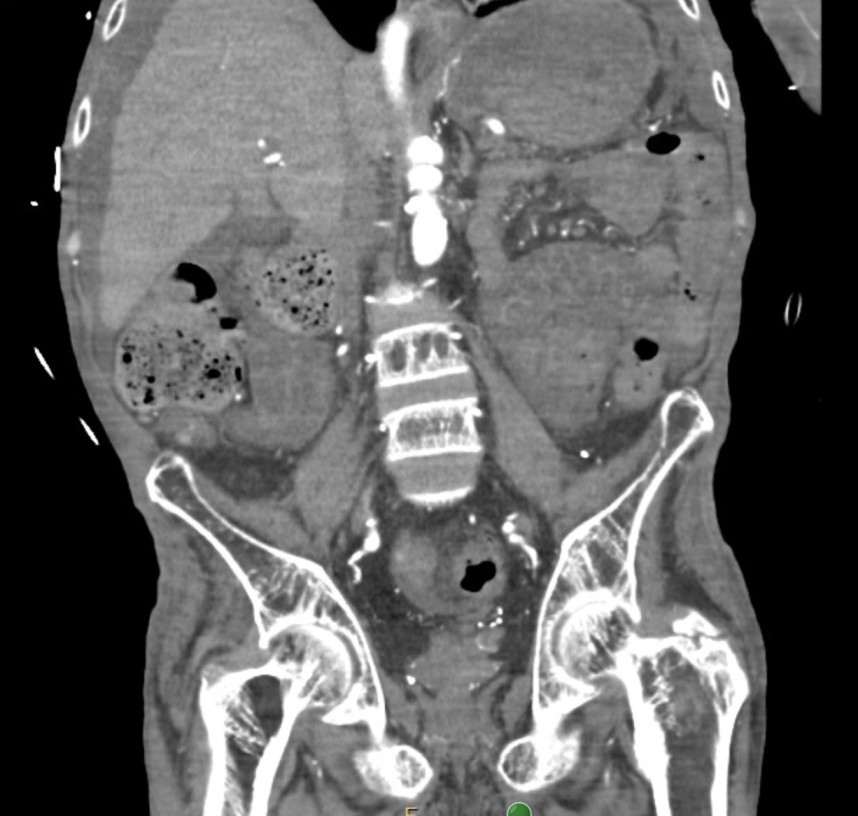Monday Poster Session
Category: Small Intestine
P4155 - Gut Instinct: Recognizing ACE-I-Induced Intestinal Angioedema
Monday, October 27, 2025
10:30 AM - 4:00 PM PDT
Location: Exhibit Hall

Raahi Patel, DO
Franciscan Health Olympia Fields
Chicago, IL
Presenting Author(s)
Raahi Patel, DO1, Varshita Goduguchinta, DO1, Navin Naik, DO2, Himanshu Ohri, MD1
1Franciscan Health Olympia Fields, Olympia Fields, IL; 2Franciscan Health Olympia Fields, Chicago, IL
Introduction: A well-known adverse effect of angiotensin-converting-enzyme inhibitors (ACEIs) is angioedema, characterized by non-pitting swelling of subcutaneous or submucosal membranes. It accounts for 20-40% of drug-induced angioedema in the United States. It is often a medical emergency due to involvement of the lips and throat. However, it can affect any part of the gastrointestinal tract and rarely affects only the small intestine, posing difficulty in diagnosing patients presenting with generalized abdominal pain. In this case, we highlight a rare presentation of ACE-i induced angioedema isolated to the small intestine after less than a year of lisinopril therapy.
Case Description/
Methods: A 54-year-old male with past medical history of liver cirrhosis, end-stage renal disease on hemodialysis status-post renal transplant failure, and a history of angioedema of the lips associated with ACE inhibitor use presented with diffuse abdominal pain, nausea, and vomiting. Labs were remarkable for elevated alkaline phosphatase of 185 and creatinine of 3.7. A computed tomography (CT) angiogram of the abdomen and pelvis revealed concerning features of jejunal thickening with edema, raising concerns for ACE inhibitor-induced angioedema so, lisinopril was held. Antihistamines such as famotidine and diphenhydramine were recommended however, the patient's symptoms improved prior to initiation, so neither that or steroids were needed. At discharge, the patient's ACE inhibitor was discontinued indefinitely.
Discussion: The incidence of ACE inhibitor-associated angioedema is 0.1-0.7%. Common areas affected are typically the lips, tongue, mouth, and upper airways. Intestinal angioedema can be seen in the clinical setting however, it is rarely diagnosed likely because diagnosis is delayed and could be mistaken for other etiologies. This could be a diagnostic challenge because patients can present with nonspecific symptoms such as abdominal pain, nausea, vomiting, diarrhea and ascites. In addition, imaging findings typically show bowel thickening and edema in the small bowel, which could be mistaken for other infectious, inflammatory or ischemic causes. Symptoms in most patients are resolved within 24-36 hours of stopping the ACE inhibitor. This case highlights the importance of considering intestinal angioedema as a differential in patients presenting with abdominal pain, nausea/vomiting and findings of jejunal thickening with edema, especially those with a known history of ACE-i associated angioedema.

Figure: Jejunal thickening with edema
Disclosures:
Raahi Patel indicated no relevant financial relationships.
Varshita Goduguchinta indicated no relevant financial relationships.
Navin Naik indicated no relevant financial relationships.
Himanshu Ohri indicated no relevant financial relationships.
Raahi Patel, DO1, Varshita Goduguchinta, DO1, Navin Naik, DO2, Himanshu Ohri, MD1. P4155 - Gut Instinct: Recognizing ACE-I-Induced Intestinal Angioedema, ACG 2025 Annual Scientific Meeting Abstracts. Phoenix, AZ: American College of Gastroenterology.
1Franciscan Health Olympia Fields, Olympia Fields, IL; 2Franciscan Health Olympia Fields, Chicago, IL
Introduction: A well-known adverse effect of angiotensin-converting-enzyme inhibitors (ACEIs) is angioedema, characterized by non-pitting swelling of subcutaneous or submucosal membranes. It accounts for 20-40% of drug-induced angioedema in the United States. It is often a medical emergency due to involvement of the lips and throat. However, it can affect any part of the gastrointestinal tract and rarely affects only the small intestine, posing difficulty in diagnosing patients presenting with generalized abdominal pain. In this case, we highlight a rare presentation of ACE-i induced angioedema isolated to the small intestine after less than a year of lisinopril therapy.
Case Description/
Methods: A 54-year-old male with past medical history of liver cirrhosis, end-stage renal disease on hemodialysis status-post renal transplant failure, and a history of angioedema of the lips associated with ACE inhibitor use presented with diffuse abdominal pain, nausea, and vomiting. Labs were remarkable for elevated alkaline phosphatase of 185 and creatinine of 3.7. A computed tomography (CT) angiogram of the abdomen and pelvis revealed concerning features of jejunal thickening with edema, raising concerns for ACE inhibitor-induced angioedema so, lisinopril was held. Antihistamines such as famotidine and diphenhydramine were recommended however, the patient's symptoms improved prior to initiation, so neither that or steroids were needed. At discharge, the patient's ACE inhibitor was discontinued indefinitely.
Discussion: The incidence of ACE inhibitor-associated angioedema is 0.1-0.7%. Common areas affected are typically the lips, tongue, mouth, and upper airways. Intestinal angioedema can be seen in the clinical setting however, it is rarely diagnosed likely because diagnosis is delayed and could be mistaken for other etiologies. This could be a diagnostic challenge because patients can present with nonspecific symptoms such as abdominal pain, nausea, vomiting, diarrhea and ascites. In addition, imaging findings typically show bowel thickening and edema in the small bowel, which could be mistaken for other infectious, inflammatory or ischemic causes. Symptoms in most patients are resolved within 24-36 hours of stopping the ACE inhibitor. This case highlights the importance of considering intestinal angioedema as a differential in patients presenting with abdominal pain, nausea/vomiting and findings of jejunal thickening with edema, especially those with a known history of ACE-i associated angioedema.

Figure: Jejunal thickening with edema
Disclosures:
Raahi Patel indicated no relevant financial relationships.
Varshita Goduguchinta indicated no relevant financial relationships.
Navin Naik indicated no relevant financial relationships.
Himanshu Ohri indicated no relevant financial relationships.
Raahi Patel, DO1, Varshita Goduguchinta, DO1, Navin Naik, DO2, Himanshu Ohri, MD1. P4155 - Gut Instinct: Recognizing ACE-I-Induced Intestinal Angioedema, ACG 2025 Annual Scientific Meeting Abstracts. Phoenix, AZ: American College of Gastroenterology.
